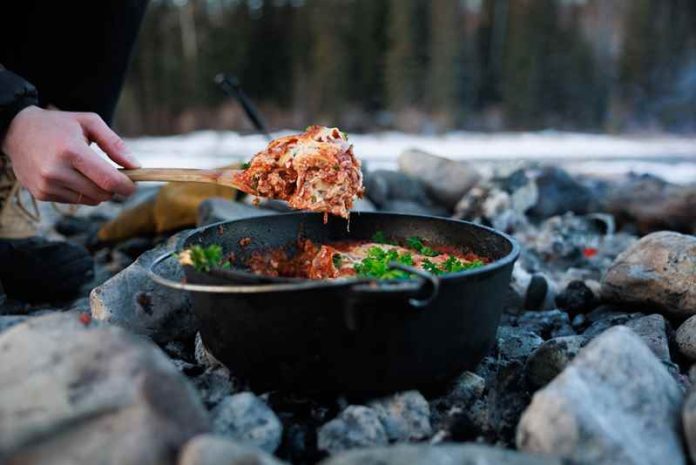Table of Contents
Introduction to Campfire Cooking
There’s something almost magical about the glow of embers and the soft crackle of a campfire that brings us back to simpler times. Campfire cooking isn’t just about sustenance; it’s an age-old tradition that unites friends and family, weaving stories and creating memories under the open sky. The joy of cooking over a campfire is in its simplicity and the unique flavor it imparts to every dish, making each meal a special event.
Amidst the array of campfire cooking equipment, the Dutch oven stands out for its versatility. This heavy-duty pot has been used for centuries and continues to be an indispensable tool for outdoor enthusiasts. Whether you’re simmering stews, baking bread, or whipping up a dessert, the Dutch oven does it all. Its cast iron construction distributes heat evenly, allowing for a wide range of culinary possibilities that go beyond the typical hot dogs and marshmallows.
Now, imagine the comforting layers of a lasagna, bubbling with cheese and rich tomato sauce, all coming together in a Dutch oven nestled in the coals of your campfire. This campfire dutch oven lasagna isn’t just a meal; it’s a centerpiece that draws everyone in with its hearty appeal. Perfect after a day of hiking or swimming, it satisfies the deepest hunger and provides the energy for tomorrow’s outdoor adventures.
Understanding Your Equipment: The Dutch Oven
The Dutch oven, a sturdy pot with a tight-fitting lid, has been a reliable companion for outdoor cooks for centuries. Its thick walls and heavy bottom make it perfect for campfire cooking, as it’s designed to withstand high temperatures and distribute heat evenly. This translates into a consistent cooking environment, akin to an oven, which is crucial for complex dishes like lasagna that require steady heat.
Types of Dutch Ovens
In order to make the ideal campfire Dutch oven lasagna, there are various types of possible ovens. Traditional cast iron Dutch ovens are prized for their durability and heat retention, while aluminum versions are much lighter, making them easier to carry if you’re backpacking. However, for our campfire Dutch oven lasagna, a cast-iron Dutch oven is highly recommended. It’s not just about the material; look for a model with legs and a flanged lid. The legs raise the oven above coals for better heat circulation, and the flanged lid can hold coals on top, ensuring even cooking from both sides—ideal for baking lasagna.
Preparing and Maintaining Your Dutch Oven
To achieve the best results, your Dutch oven requires some preparation and maintenance. Seasoning is the first step—a process that involves coating the oven with a layer of oil and heating it to create a non-stick surface. This not only prevents rust but also creates a surface that becomes more non-stick over time. Before your trip, ensure your Dutch oven is well-seasoned; this will make cooking and cleaning easier at the campsite.
- Clean your Dutch oven after each use with hot water and a brush. Avoid soap, as it can strip the seasoning.
- Dry it completely to prevent rust. You can heat it on the fire for a few minutes to evaporate any moisture.
- Apply a thin layer of cooking oil to the surface after drying to protect it until its next use.
Maintenance is simple, but it’s an essential part of ensuring your Dutch oven lasts for many camping trips to come.
“`
Section 3: Preparing for Your Campfire Dutch Oven Lasagna
Embarking on an outdoor adventure doesn’t mean you have to skimp on the quality of your meals, especially not with the right preparation. Imagine sitting by a warm campfire with a plate of delicious campfire Dutch oven lasagna; let’s get you set up for that experience. First, we’ll need to gather our ingredients and equipment.
Ingredients and Equipment Needed
- Lasagna noodles
- Marinara sauce
- Ricotta cheese
- Mozzarella cheese, shredded
- Grated Parmesan cheese
- Ground beef or Italian sausage
- Garlic, onions, and any desired vegetables
- Herbs and spices (basil, oregano, salt, pepper)
- Olive oil
- Dutch oven (preferably cast-iron with legs and a flanged lid)
- Campfire gloves or oven mitts
- Charcoal briquettes or firewood
- Metal tongs and a shovel or spade (for coal management)
- Chopping board and knife
- Mixing bowls and utensils
- Aluminum foil (optional for easier cleanup)
- Lid lifter or improvised lifter (if the Dutch oven does not have a handle)
With our list complete, it’s advisable to do as much prep work as possible before leaving home. If you’re chopping veggies, grating cheese, or cooking meat, doing this ahead of time will save you effort at the campsite, allowing more time to relax and enjoy nature.
Preparing Ingredients Ahead of Time
Efficiency is key when you’re out in the wild. Here are some time-saving tips:
- Pre-cook meats: Brown the ground beef or sausage at home, drain the fat, and pack it in a cooler.
- Chop vegetables: Dice onions, slice mushrooms, or cut any other veggies you plan to include and store them in ziplock bags.
- Shred and mix cheeses: Combine your ricotta, mozzarella, and Parmesan cheese at home. This also allows the flavors to meld together nicely.
- Pre-boil noodles: Some prefer to pre-boil their campfire Dutch oven lasagna noodles to shorten the cooking time at the campsite, though no-boil noodles are an excellent alternative.
- Portion your sauce: If using homemade marinara, portion it into containers for easy layering during assembly.
Once your ingredients are neatly packed and ready to go, it’s time to focus on the campfire that will transform these components into your gourmet outdoor meal.
Setting Up a Safe and Efficient Campfire
To ensure safety and efficiency while cooking with a Dutch oven over a campfire, follow these guidelines:
- Site Selection: Use existing fire rings or pits if available. Otherwise, choose a spot away from trees and brush, and surround your fire area with rocks.
- Firewood and Charcoal: Gather dry firewood of varying sizes. If you’re using charcoal briquettes, bring enough to create a bed of coals that can be replenished as needed.
- Safety Measures: Keep water or a fire extinguisher close by in case you need to douse the flames quickly.
- Airflow: Ensure your campfire has good airflow for efficient burning. The Dutch oven should sit above a bed of hot coals rather than open flames to cook evenly.
- Heat Management: Learn to gauge the temperature by placing your hand above the coals. You should be able to hold it there for about 4 seconds at the optimal cooking heat.
By preparing your ingredients ahead of time and setting up a controlled, safe campfire, you’re well on your way to enjoying a hearty campfire Dutch oven lasagna in the great outdoors. Remember, the key to a smooth campfire cooking experience lies in the prep work done before you even strike the first match.
Section 4: Assembling Your Campfire Dutch Oven Lasagna
Now that your ingredients are prepped and your campfire is glowing, it’s time to dive into the heart of campfire cooking – layering your campfire Dutch oven lasagna. This critical step is where your meal begins to take shape, so let’s walk through it together, ensuring each layer melds perfectly for a mouthwatering result.
Step-by-Step Layering Instructions
Begin with a light coating of oil on the bottom of your Dutch oven to prevent sticking. Then, lay down your first layer of noodles. Overlap them slightly to create a solid base. Spoon on a layer of your pre-prepared sauce, spreading it evenly over the noodles. Next, add a generous sprinkling of cheese, followed by your pre-cooked meats and chopped vegetables. Repeat these layers until the Dutch oven is nearly full, finishing with a final layer of cheese on top.
- Lightly oil the bottom of the Dutch oven.
- Place the first layer of noodles, overlapping slightly.
- Spoon and spread a layer of sauce over the noodles.
- Add a layer of cheese, then meat, then vegetables.
- Repeat the layering process, finishing with cheese on top.
Proportions and Distribution
The key to a campfire Dutch oven lasagna that’s as delightful to eat as it is to look at is in the proportions and distribution of ingredients. Ensure that each layer has an even spread of sauce, cheese, meats, and vegetables. This even distribution helps with cooking the lasagna uniformly, preventing any dry spots or areas with too much moisture. Aim for consistency in each bite, which will also make the campfire Dutch oven lasagna easier to serve once it’s finished cooking.
Customizing Your Campfire Dutch Oven Lasagna
Campfire cooking is all about flexibility and personal preference. Feel free to add your own twist to the classic lasagna recipe. Consider incorporating different cheeses for a unique flavor profile, or mix in some spinach between the layers for an extra pop of color and nutrition. For those with dietary restrictions, gluten-free noodles are a great substitute, and plant-based cheeses and meats can easily accommodate a vegan diet. The beauty of a Dutch oven lasagna is its adaptability, so don’t hesitate to get creative!
- Experiment with different cheeses like smoked gouda or pepper jack.
- Add greens such as spinach or kale for added nutrients.
- Substitute with gluten-free noodles or vegan cheese for dietary needs.
With your campfire Dutch oven lasagna now expertly layered and customized to your taste, you’re one step closer to enjoying a gourmet meal by the campfire. Remember, the Dutch oven is an incredibly versatile tool, so trust it to work its magic on your campfire Dutch oven lasagna. In the next section, we’ll tackle the nuances of cooking this hearty dish to perfection over an open fire.
How to Cook Campfire Dutch Oven Lasagna
Gather around the campfire, adventurers, because it’s time to transform our assembled layers of lasagna into a bubbling masterpiece. Cooking over an open fire is an art, and with our Dutch oven filled with lasagna, we’re ready to tackle the challenge. Let’s dive into the process of achieving that golden, cheesy perfection amidst the crackling flames.
Heating the Dutch Oven and Managing Campfire Coals
First things first, we need to talk about heat. The key to campfire cooking is managing your heat source – in this case, the coals. You’ll want to ensure a consistent temperature, which can be tricky outdoors. Start by spacing out coals evenly under your Dutch oven to create a bed of heat. Think of it as an outdoor stovetop setting. If you’re aiming for baking temperature, which is around 350 degrees Fahrenheit, you’ll need about 25 briquettes. Place them thoughtfully, with more on top and fewer on the bottom, to mimic the heating effect of an oven and prevent scorching the bottom layer of your lasagna.
Timing and Signs of Perfectly Cooked Campfire Dutch Oven Lasagna
Patience is a virtue, especially when you’re waiting for campfire Dutch Oven lasagna. Typically, you’re looking at about 30 minutes of cook time, but keep in mind, every campfire is unique. To gauge doneness, look for bubbling edges and a gently browned cheese topping. A good sign is when the aroma of perfectly melded cheese and tomato sauce becomes too tantalizing to ignore. If you have a thermometer handy, you’re aiming for an internal temperature of 165 degrees Fahrenheit, which indicates a thoroughly cooked dish.
Safety Precautions While Cooking Over an Open Fire
Safety should never take a backseat, especially when working with fire. Always keep a bucket of water or sand nearby for emergencies. Use heat-resistant gloves or pot holders when handling the hot Dutch oven. It’s also smart to have long-handled utensils to maintain a safe distance from the flames. When adjusting coals or the pot, do so carefully to avoid sparks or tipping. And remember, never leave your cooking unattended; the forest is a shared space, and we must respect it by preventing wildfires.
As your lasagna bakes, let the magic of the outdoors enhance your culinary experience. Enjoy the stars, share stories, and anticipate the feast. Soon enough, you’ll be savoring a campfire lasagna that proves gourmet cuisine truly can be enjoyed anywhere.
Section 6: Serving and Enjoying Your Campfire Creation
Let’s imagine you’ve just navigated the art of cooking lasagna over an open flame, your Dutch oven now brimming with layers of bubbly cheese and savory sauce. The aroma is tantalizing, but before you can indulge, you must first master the final hurdle: serving your campfire creation without incident.
Safely Removing the Dutch Oven from the Campfire
The key to safety here is having the right tools and technique. Use a pair of heavy-duty oven mitts or pot holders designed for high heat. A lid lifter specifically made for Dutch ovens is also invaluable. Approach the fire calmly and confidently; hastily snatched pots lead to accidents. Carefully lift the Dutch oven off the coals, keeping it level to avoid spills. Place it on a sturdy, heat-resistant surface away from any flammable materials. Allow it to sit for a few minutes – not only does this let the flavors meld, but it also reduces the risk of burning eager mouths.
Complementary Side Dishes and Pairings
As your lasagna rests, consider the accompaniments. For an outdoor feast, simplicity often reigns supreme. A rustic loaf of bread, crisped up by the fire’s remnants, makes for an excellent companion, perfect for sopping up any extra sauce. A fresh salad of mixed greens dressed with olive oil, lemon, and a touch of salt adds a refreshing contrast to the richness of the lasagna. If you’re feeling adventurous, grilled vegetables or a skewer of seasoned meats could round out the meal. And for beverages? A robust red wine, if permissible in your camping area, harmonizes beautifully with the lasagna’s flavors, while chilled sparkling water with a slice of lemon offers a non-alcoholic refreshment.
Storing Leftovers in a Camp Setting
Should you find yourself with more lasagna than appetites can handle, proper storage ensures you can enjoy it again. In a camp setting, cool the lasagna quickly by sectioning it into smaller portions. Store each piece in airtight containers and place them in a cooler with sufficient ice packs. Remember, food safety is paramount; leftovers should be consumed within a couple of days, especially if you’re battling high temperatures during your outdoor adventure.
With the lasagna safely served, sides paired for a balanced spread, and any leftovers securely stored, all that’s left is to gather around the campfire. Share stories, soak in the night sky, and relish in the satisfaction of a meal well-made and well-enjoyed amidst the beauty of nature.
Embrace the Outdoors with Gourmet Campfire Cuisine
As we reach the conclusion of our campfire culinary journey, the satisfaction derived from creating a gourmet meal like lasagna in the untamed embrace of the great outdoors is undeniable. The experience intertwines the rustic charm of campfire flames with the refined flavors of a beloved Italian dish. It’s about more than just the food—it’s the fulfillment of challenging oneself to cook a complex meal amidst the simplicity of nature.
Recapping the Culinary Adventure
Cooking outdoors, as we’ve explored, is an adventure that tantalizes all senses. From the preparation of fresh ingredients to the sizzle of the Dutch oven over an open flame, each step taken has been a dance of anticipation and craft. The layers of pasta, cheese, and sauce, assembled with care, transform under the heat of the coals into a sumptuous feast that rivals any home kitchen creation. This isn’t just cooking; it’s an act of alchemy that marries the primal with the sophisticated.
The rewards extend beyond the palate, offering a sense of accomplishment and connection. Gathering around the fire to share a meal prepared with effort and patience reinforces bonds and becomes a memory etched into the narrative of our outdoor experiences. It’s a testament to how gourmet cuisine can be reimagined under the stars and the shared laughter that echoes into the night is as much a part of the meal as the lasagna itself.
Carrying the Experience Forward
To embrace the outdoors with gourmet campfire cuisine is to carry forward a tradition that spans generations and cultures. It’s the warmth of heritage, the embrace of communal living, and the pure joy of eating food cooked slowly over a fire. The next time you venture into the wild, remember that the flames are not just for warmth and light but also for the creation of exquisite meals that elevate your camping experience.
And as the last morsels of lasagna are savored, and the embers begin to fade, take pride in the knowledge that you’ve mastered not just the art of campfire cooking, but the art of making every environment a place where gourmet dining can flourish. Let this experience inspire future outdoor escapades, and may the recipes you explore be as limitless as the great outdoors itself.
So, as we wrap up this tutorial, whether you’re a seasoned camper or a novice to the flames, take this knowledge and these flavors with you. Wherever your travels may lead, may they be filled with the spirit of adventure and the pleasure of good food, lovingly prepared and joyfully shared.
















